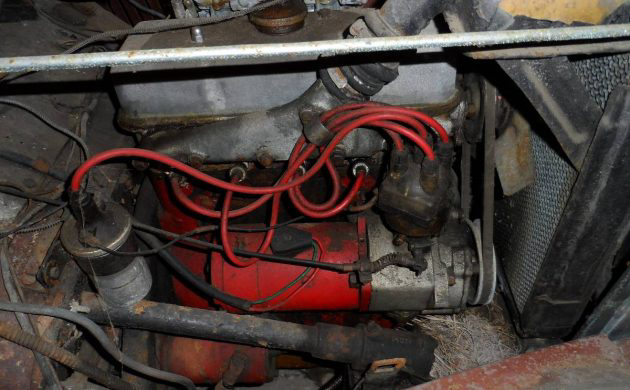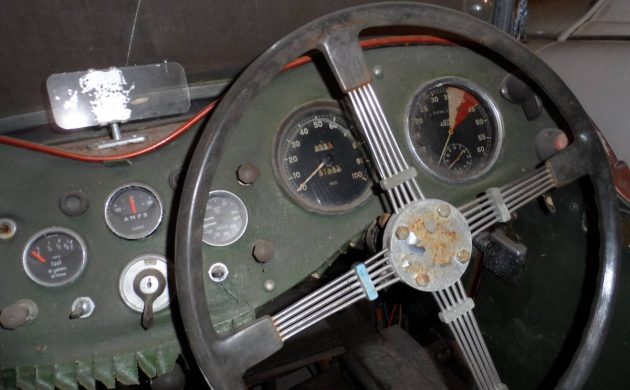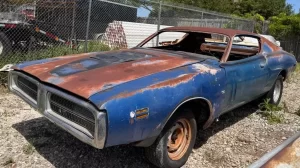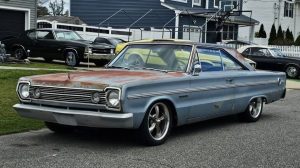This MG TD is an interesting car because it’s not what you can see that’s important, but what is hiding under the skin that holds all of the value. What you can see is an ordinary MG TD body, but the 1934 Singer LeMans chassis and drive-train makes it something a bit special. I have to say a big thank Barn Finder Andria A for spotting this classic for us. Located in New Market, Minnesota, you will find the car listed for sale here on Craigslist with an asking price of $8,500.
The body of the MG looks quite good, with no obvious signs of rust or corrosion issues. The paint looks tired, but given how easy these little cars are to dismantle, restoring the panels and paint should be a fairly easy task. Once we get past the panels, paint, and glass, things become slightly more complex with the car. The chassis hiding under that MG body is not original but is actually a 1934 Singer LeMans chassis. This is not the only part of this car to hail from the factories of Singer Motors Limited, as we will see.
Under the MG hood is not your standard 1,250cc MG engine, but the 972cc Singer 4-cylinder engine. In fact, not only is the chassis a LeMans chassis, but everything else is from a 1934 LeMans as well. This includes the engine, transmission, suspension, and wheels. This is where the true value of this car lies, and that’s all tied to that chassis and drive-train. For someone who is looking at the restoration of a Singer LeMans, this is a gold mine. The condition of the drive-train is unknown, but the car was running until it recently went into storage.
There’s really not a lot that can be said about the interior, as it is a mix of so many different components. The gauges are from a Jaguar, the dash is a TD item, the wheel is a Brooklands wheel. The whole thing looks quite shabby, and it really is in need of restoration. Still, I’d be pretty inclined to remove all of the non-Singer components and try to source a Singer body, interior, and trim if possible.
I’ve been talking a lot about the value of the Singer components in this car, and for very good reason. After a lot of very careful detective work, it appears that there were only around 12 LeMans cars built in 1934, which makes the car a true rarity. For someone looking at a Le Mans restoration, or who has a bare LeMans body, then this is a perfect opportunity for them. On the surface, this car looks like a promising MG TD restoration project. However, like mining for gold or diamonds, sometimes you have to dig a little deeper to hit the jackpot. This car proves that point.
















Only 12??? LeMans built in 1934! Wow! This a rare item. I’d want to be able to drive this and on the off chance that there was a body available get the MG body off and replace it. Makes me wonder how long ago this marriage was made. Great find and great write-up! Thank you
My apologies @NotSure and Martin Horrocks. Old age is really catching up. In trying to member the late seventies I seem to recollect that the figure for the 6 cylinder cars are correct but obviously not for the 4 cylinder cars as there are plenty of them still around here in UK and in South Africa. Sorry about that guys.
A friend of mine in South Africa owned both a 1934 four cylinder and a six cylinder Singer Le Mans. I don’t remember how many of each were made but I believe the figure of 12 was correct for the 4 cylinders and maybe 6 of the 6 cylinder cars. I drove both of them but they were very cramped for my 6 ft 2 in frame so didn’t get the pleasure out of them that I thought I would, however, great little cars.
Rather than a Singer 9 Le Mans this (hiding under the TD body) is a still desirable Singer 9 Sports. The 9 Sports have a 35 hp engine vs the standard 9’s 31 hp. The Le Mans produced 38 hp @ 5000 rpm and the big 1 1/2 Le Mans were propelled by a 1493cc six rated at 48 hp @ 4800 rpm.
Obviously one cannot get a decent idea as to the state of the chassis, etc. from the Craigslist add, but it should have 18″ wheels rather than the 16s.
See Cars and Classics advert for a Singer 9 Sports where one can easily compare the Craigslist engine photo to the unrestored 9 Sports:
https://www.carandclassic.co.uk/car/C1075997
Singer’s Le Mans racing history from 1933 to 1939 with one last entrant in 1949:
http://www.singercars.com/history/lemans.html
Note the 1933 entry of a 9 Sports which finished 13th overall.
Restoring the car offered to correct 9 Sports configuration would be a major undertaking. However a Singer 9 Sports special might be a reasonable though challenging undertaking.
@James HGF. Thanks for the Singer website history. I always thought my friends 6 cylinder Le Mans was a 2 litre. (So did he) I learn something new every day of my life and I’m nearly 80 !
How cool is that find…..
@Adam Clarke. Instruments are from Jaeger not Jaguar. Common gauge swap and I believe Jaeger was eventually swallowed up by Smiths.
@ James HGF. I believe the seller thinks at least the rear wheels are Singer. The stance and offset back there looks better than most T series MGs. Funny that the title is going to say 1934 MG instead of 1934 Singer. Or, conversely, say 1954 Singer. Great find!
Adam… auto correct probably kicked you in the butt! They are Jaeger gauges… not Jaguar.
I fear the write up is wishful thinking based on a misconception.
I don´t know where your build number of 12 comes from as the Singer Le Mans was a production car built for a few years, trading on the improbable success of the 1933 Singer 9 at Le Mans which James HGF mentions. They built plenty and were popular as trials cars in the 1930s always having a following as a cheaper and less common alternative to a 1930s MG. If you want a Singer Le Mans in excellent condition there´s usually one for sale somewhere in the world, like this one in UK.
https://www.ebay.co.uk/itm/173782287387
So if a perfect 3 owner car with full history is less than $35000 there´s not a lot of point in the route suggested in the write up.
If you are looking for a truly rare Singer Le Mans, try this:
https://www.escuderia.com/singer-le-mans-saloon-1934/
That one probably is almost unique and it is real. I live in Madrid if anyone wants to follow the saloon up.
Keep trying to post this and getting server error, so apologies if there is a multiple posting from me.
@ James HGF is well-informed and the write up is not correct in claiming only 12 Singer Le Mans were built. It was a production model available for a few years and has always been a well-liked and well-known alternative to 1930s MGs.
But they are easy enough to find if you want one and not particularly valuable (a perfect car with full history of 3 owners from new is on offer in UK for less than $35K) so BF´s suggested route of building a car out of these parts would have you very quickly under water.
Personal view is an excellent parts car if your looking for value. Especially to LeMan owners or TD owners with a view to selling on either marque. Otherwise a bit like a custom car which in my opinion often has a limited market.
This is much more of a ‘bitsa’ even when considering the Singer parts alone.
The block is a ’35-37 style casting, not a ’34 and the carbs are completely wrong. They should be Solex FI or the later FAI.
There is no magneto, only a distributor and coil ignition.
The valve cover is alloy, which was used on the Le Mans, but the head has the straight style spark plugs indicating a ‘bathtub’ head as used on the saloons, Coupes and 4 seater Sports. Angled plugs would indicate a semi hemi head as used on the Le Mans ‘Speed’ engines and later ’35 – ’37 engines.
The sump is also pressed steel, not the finned alloy casting as used on the Le Mans. The LC stamp on the front cover casting indicates possibly a Bantam van or Saloon engine.
It’s very hard to see the type of chassis, but the ’34 Le Mans has a ‘double drop’ frame where the frame dips down behind the front springs and kicks up over the rear axle. ’36 / ’37 cars had underslung frames at the back.
Production numbers were far higher than suggested and certainly in the 100’s for the Le Mans model alone in 1934. The model was introduced in the fall of 1933. The Le Mans Nine was produced until 1937.
I own a ’36 Nine Le Mans Special Speed Model, as well as a ’33 and ’34 Nine Sports and have played with these cars for over 40 years now.
Some additional Singer Info to clarify:
There were @857 Le Mans 2 seaters built between the fall of 1933 and the summer if 1937. @402 of those were the ’34 model years starting in the fall of 1933.
There were three variations of the ’34 model with changes made during production that year.
The Le Mans Special Speed Model was introduced in the fall of 1934 as a 1935 model with a considerable number of improvements made to both the body and mechanics. The standard style model was still offered, but I suspect that was to use up the stock of parts.
1935 was the only year that the full range of sports models were call a Le Mans; 2 seater, 4 seater and Coupe.
The 6 cylinder Le Mans 1.5L was sold as two variants; the Mark 1 which was basically a Nine 4 cylinder car with the 14HP twin carb six Saloon/Sports engine shoe-horned into it and fitted with larger brakes. The Mark 2 was introduced with a cross-flow head and triple SU carbs. The body was moved back on the frame and many other components were uprated and improved. @70 of these were produced.
In 1937 a new 1.5L sports car was introduced as a prototype. This was a close-coupled 2/4 seater that foreshadowed the Roadster that was to come in 1939. Known as the “B37” it was the best sports car Singer never sold. 12 were made and used extensively in trials and rallies.
4 Nine racing cars were built for the Irish Tourist Trophy and 3 of the 4 crashed in that race at the same corner from steering failure. They are incorrectly referred to as the “TT Replicas’ as Singer intended to sell copies of them in limited production. None were built, but the 4 original cars still survive.
Nine Coupes are a bit more numerous that you might suspect and there are 5 known in the USA, with a 6th that was a Coupe but has been converted with a racing body. The Coupe bodies did not survive well.
Hope that helps with some Singer facts to put this MG-Singer into context. I can see someone doing the reverse; putting a Singer body on an MG chassis perhaps due to the ease of finding parts, but the reverse is weird. That said, I knew of a Lagonda Rapier that had been fitted with a Singer Le Mans body, so there you go!
I give 9 out of ten to the Singer Owner as he is almost correct the rest disregard. I have owned Singers since 1951 and owned most of the models made by the company.
John! Great to see you chime in! I defer to The Jedi Master of Pre-war Singers and am honoured to receive a 9 out of 10 from such august company.
For those of you reading John has owned more pre-war Singers than I’ve had hot breakfasts…and some very notable ones too.
Greetings from Canada John, and maybe I’ll see you on the ASCO stand at Beaulieu this year. Stay well!